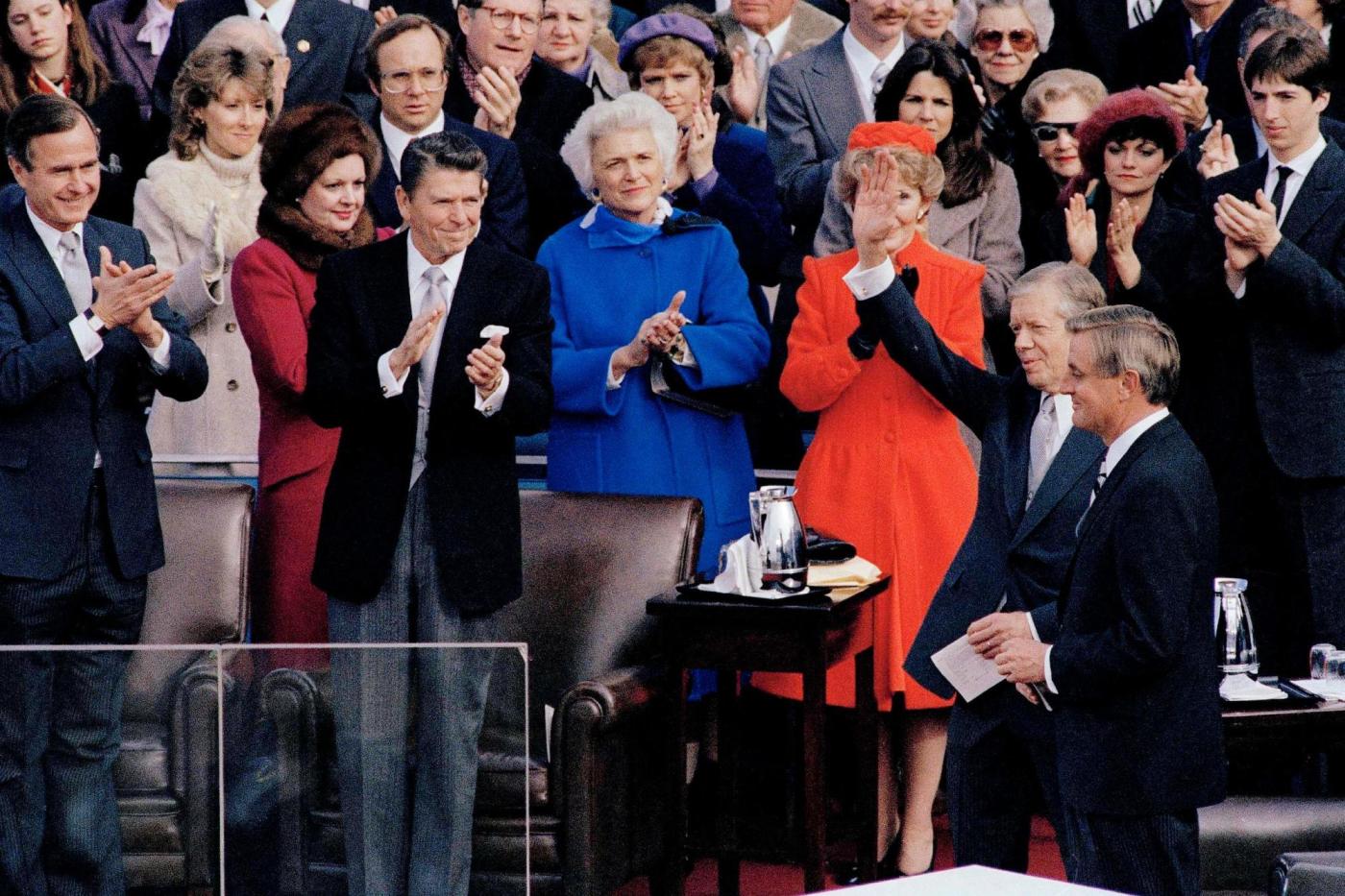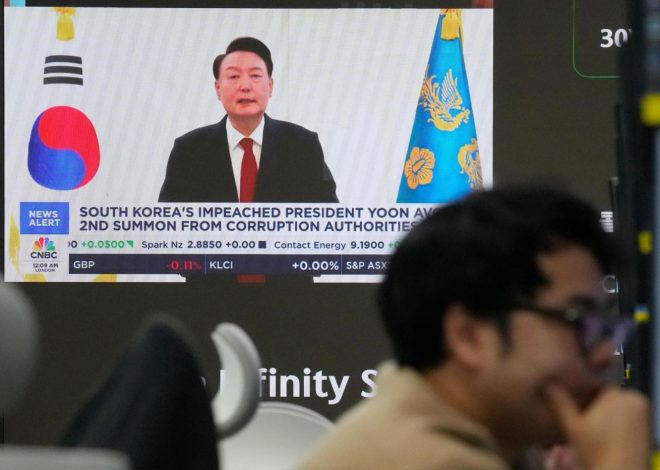
An American tradition: Defeated candidates attending the president-elect’s inauguration
By THOMAS BEAUMONT, Associated Press
In January 1981, Jimmy Carter nodded politely toward Ronald Reagan as the new Republican president thanked the Democrat for his administration’s help after Reagan resoundingly defeated Carter the previous November.
Twenty years earlier, after a much closer race, Republican Richard Nixon clasped John F. Kennedy’s hand and offered the new Democratic president a word of encouragement.
The U.S. has a long tradition of defeated presidential candidates sharing the inauguration stage with the people who defeated them, projecting to the world the orderly transfer of power. It’s a practice that Vice President Kamala Harris will resume on Jan. 20 after an eight-year hiatus.
Only once in the television era — with its magnifying effect on a losing candidate’s expression — has a defeated candidate skipped the exercise. That candidate, former President Donald Trump, left for Florida after a failed effort to overturn his loss based on false or unfounded theories of voter fraud.
With Harris watching, Trump is scheduled to stand on the Capitol’s west steps and be sworn in for a second term.
Below are examples of episodes that have featured a losing candidate in a rite that Reagan called “nothing short of a miracle.”
2001: Al Gore and George W. Bush
Democrat Al Gore conceded to Republican George W. Bush after 36 days of legal battling over Florida’s ballots ended with a divided Supreme Court ruling to end the recount.
FILE – Vice President Al Gore, far right, who conceded to Republican George W. Bush after 36 days of legal battling over Florida’s ballots, looks on as Bush is sworn in as the 43rd president of the United States, outside the U.S. Capitol in Washington, Jan. 20, 2001. (AP Photo/Ron Edmonds, File)
But Gore, the sitting vice president, would join Bush on the west steps of the Capitol a month later as the Texas governor was sworn in. After Bush took the oath, he and Gore shook hands, spoke briefly and smiled before Gore returned to his seat clapping along to the presidential anthem, “Hail to the Chief.”
A disappointed Gore accepted the outcome and his role in demonstrating continuity of governance, former Gore campaign spokeswoman Kiki McLean said.
“He may have wished, ‘I wish that was me standing there,’” McLean said. “But I don’t think Gore for one minute ever doubted he should be there in his capacity as vice president.”
2017: Hillary Clinton and Donald Trump
Democrat Hillary Clinton was candid about her disappointment in losing to Trump in 2016, when — like Gore against Bush — she received more votes but failed to win an Electoral College majority. “Obviously, I was crushed,” she told Howard Stern on his radio show in 2019.
FILE – Former Sen. Hillary Clinton and former President Bill Clinton arrive on the West Front of the U.S. Capitol, in Washington, Jan. 20, 2017, for the inauguration ceremony of Donald J. Trump as the 45th president of the United States. (Win McNamee/AP Photo File)
Calling Inauguration Day “one of the hardest days of my life,” Clinton said she planned to attend Trump’s swearing-in out of a sense of duty, having been first lady during her husband’s presidency from 1993 to 2001. “You put on the best face possible,” Clinton said on Stern’s show.
2021: Mike Pence (with Trump absent) and Joe Biden
Trump four years ago claimed without evidence that his loss to President Joe Biden was marred by widespread fraud. Two weeks earlier, Trump supporters had stormed the Capitol in a violent siege aimed at halting the electoral vote certification.
FILE – Outgoing Vice President Mike Pence looks on as incoming President Joe Biden embraces first lady Jill Biden, his son Hunter Biden and daughter Ashley Biden after he was sworn-in as the 46th president of the United Staes, at the U.S. Capitol in Washington, Jan. 20, 2021. Incoming Vice President Kamala Harris applauds at left. (AP Photo/Carolyn Kaster, File)
Instead, then-Vice President Mike Pence was the face of the outgoing administration.
“Sure, it was awkward,” Pence’s former chief of staff Marc Short said.
Still, Pence and his wife met privately with Biden and his wife to congratulate them in the Capitol before the ceremony, and escorted newly sworn-in Vice President Kamala Harris and her husband out of the Capitol afterward, as tradition had prescribed, Short said.
“There was an appreciation expressed for him by members of both chambers in both parties,” he said.
1993: George H.W. Bush and Bill Clinton
Bush stood on the Capitol’s west steps three times for his swearing-in — as vice president twice and in 1989 to be inaugurated as president. He would attend again in 1993 in defeat.
FILE – Outgoing President George Bush, far right, accompanied by President-elect Bill Clinton, depart the White House for Capitol Hill to attend the swearing in ceremony of Clinton as the nation’s 42nd president, in Washington, Jan 20, 1993. (AP Photo/Doug Mills, File)
He joined Bill Clinton, the Democrat who beat him, on the traditional walk out onto the east steps. Bush would return triumphantly to the inaugural ceremony eight years later as the father of Clinton’s successor, George W. Bush.
Related Articles
What to watch as Pete Hegseth faces questions about his experience and personal past
Pete Hegseth, Trump’s nominee for defense secretary, faces crucial test at confirmation hearing
Special counsel who investigated Trump says his team ‘stood up for the rule of law’
Canada ready to buy more American products to appease Trump’s tariff threat, ambassador says
This is what the Homeland Security secretary has to say about his border record
1961: Richard Nixon and John F. Kennedy
Nixon had just lost the 1960 election by fewer than 120,000 votes in what was the closest presidential contest in 44 years. But the departing vice president approached Kennedy with a wide grin, a handshake and an audible “good luck” just seconds after the winning Democrat’s swearing-in.
Nixon would have to wait eight years to be sworn in as president, while his losing Democratic opponent — outgoing Vice President Hubert Humphrey — looked on. He was inaugurated a second time after winning reelection in 1972, only to resign after the Watergate scandal.
1933: Herbert Hoover and Franklin D. Roosevelt
Like Bush, Hoover would attend just one inauguration as a new president before losing to a Democrat four years later. But Democrat Franklin Roosevelt’s 1933 swearing-in would not be Hoover’s last. Hoover would live for another 31 years, see four more presidents sworn in, and sit in places of honor at the two inaugurations of Republican Dwight D. Eisenhower.
1897: Grover Cleveland and Benjamin Harrison
Cleveland, the sitting Democratic president, lost reelection in 1888 while winning more popular votes than former Indiana Sen. Benjamin Harrison. But Cleveland still managed to hold Harrison’s umbrella while the Republican was sworn in during a rainy 1889 inauguration.
Elected to a second, non-consecutive term in 1892, Cleveland, however, would stand solemnly behind William McKinley four years later at the Republican’s 1897 inauguration, leaving the presidency that day after losing the 1896 nomination of his own party.
Cleveland was the only president to win two non-consecutive terms until Trump’s victory in November.
Beaumont reported from Des Moines, Iowa.


